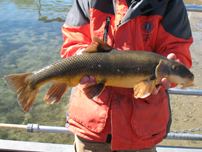Phylum Chordata Rank Species | Higher classification Catostomus | |
 | ||
Similar Catostomus discobolus jarrovii, Catostomus, Roundtail chub, Razorback sucker, Speckled dace | ||
Catostomus latipinnis (flannelmouth sucker) is a North American fish identified by its enlarged lower lips. It belongs to the genus Catostomus, commonly known as suckers. Historically, the flannelmouth sucker ranged in the Colorado River Basin, including parts of Wyoming, Utah, Colorado, New Mexico, Nevada, California, and Arizona; however, this species has been entirely extirpated from the Gila River Basin in Arizona.
Contents
Description
The flannelmouth sucker's body is long, starting with a thick anterior that moves down to a thin posterior; respectively, this causes the head to be relatively short and thick. The lower lips are noticeably bulky, with thick and fleshy lobes. In addition, the flannelmouth sucker has large fins, but relatively small scales. Young fish are usually silvery-colored all over, but adults have a typical light gray or tan coloration (often with a lighter underside). Strangely, no bright colors have been found in populations of this species in Arizona, but are found in those from the Colorado basin. Adult fish can also grow to a length of 26 inches and weigh about 8 pounds. It is one of the largest of all suckers.
Range
The flannelmouth sucker can be found in parts of Wyoming, Utah, Colorado, New Mexico, Nevada, California, and Arizona. In Arizona, this species is found in the Colorado River and its larger tributaries. In the mid 1970s, the Arizona Game and Fish Department introduced the fish below the Davis Dam, and the population still persists today.
Habitat
While flannelmouth suckers are restricted to larger rivers, its larvae tend to live in shallow areas. Larvae also like deeper water when they are not feeding. In addition, adult suckers prefer great amounts of cover and shade during the daytime.
Diet
This species is known to eat inorganic material, planktonic organisms such as copepods, filamentous algae and other macroinvertebrates; this was discovered by examining the stomach contents of flannelmouth sucker larvae.
Reproduction
Breeding season for the flannelmouth sucker occurs in the months of March through July. In Arizona, the fish tend to "run" upstream specifically to spawn, and then immediately leave towards the mainstream. Fins of both sexes often become orange during reproduction.
Conservation
The flannelmouth sucker is an unprotected species—although not entirely endangered, the species faces many threats. These threats include alterations of river habitats (thermal and hydrologic) caused by hydroelectric dams; blockage of migration; and predation by introduced organisms. In Arizona, the Grand Canyon Protection Act of 1992 reduced the random fluctuation of water releases from the nearby dam in Glen Canyon, and is still enforced today.
